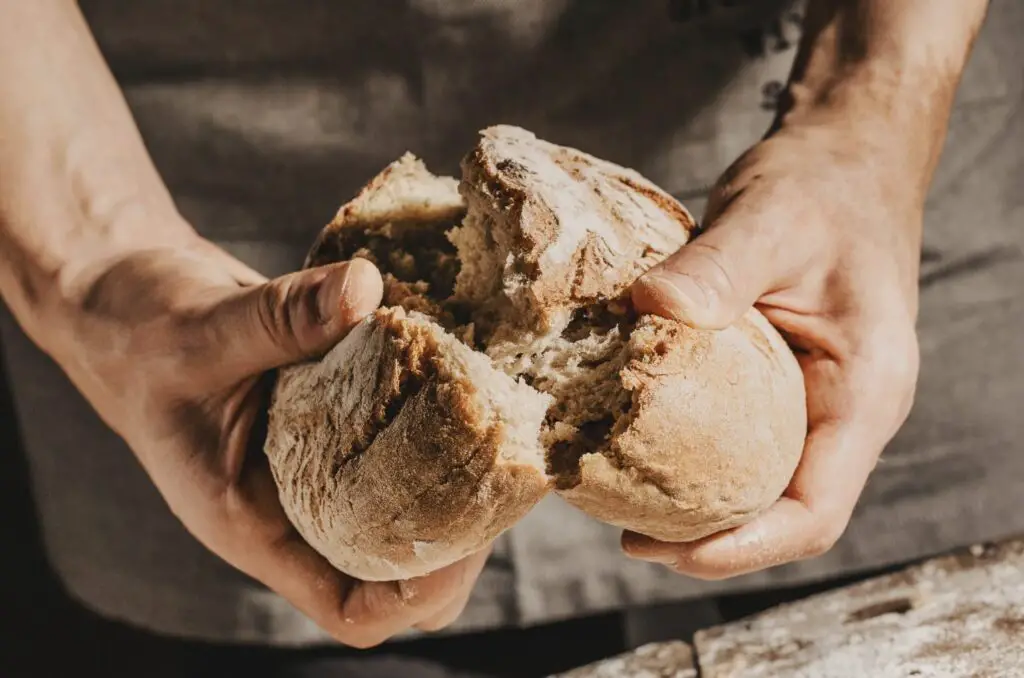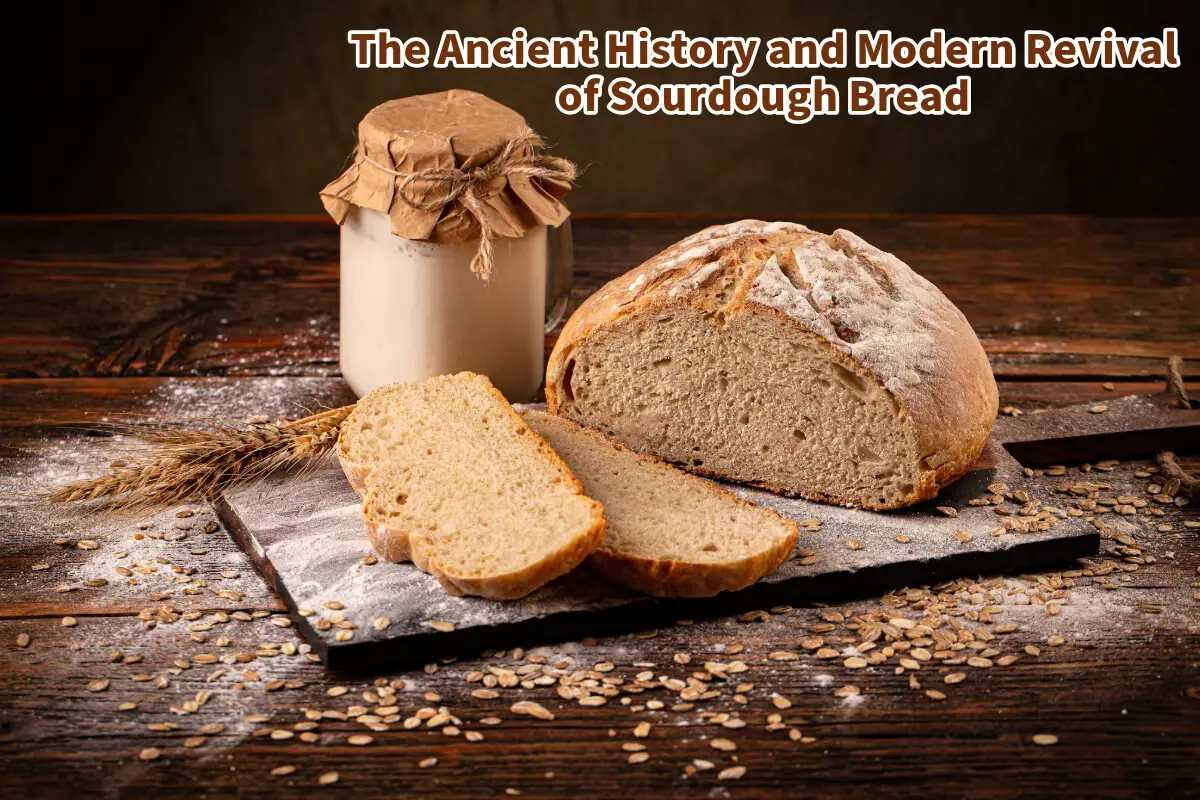I have always had a fondness for sourdough bread. Its unique tangy flavor and chewy texture have made it a staple in my kitchen. However, it wasn’t until recently that I delved into its fascinating history and discovered just how ancient this beloved bread is.
Sourdough bread’s origins trace back to the dawn of civilization, with roots embedded deeply in the agricultural developments of ancient Egypt and the Fertile Crescent. This bread nourished the bodies of ancient peoples and connected them to an intricate tradition of fermentation and baking that has persisted through millennia.
Table of Contents
- Ancient Origins of Sourdough Bread
- Sourdough Bread’s Journey to America
- The Science Behind Sourdough
- Reviving Ancient Techniques in Modern Times
- Related Recipes
Ancient Origins of Sourdough Bread
The story of sourdough bread began around 10,000 years ago when humans first began cultivating grains in the Fertile Crescent. This region, often called the cradle of civilization, saw the dawn of agriculture. Wheat became a staple among the grains cultivated, and with it, the practice of bread-making emerged. However, it was in ancient Egypt that the true art of sourdough fermentation was developed and perfected.
Sourdough in Ancient Egypt
Egyptians are credited with discovering the fermentation process that would become the foundation of sourdough bread. This likely happened accidentally when the dough was left out, and wild yeast from the environment caused it to ferment.
This discovery transformed bread-making, giving rise to bread that was more nutritious and longer-lasting.
Recent scientific advancements have allowed us to delve deeper into this ancient tradition. In 2019, researchers revived 4,500-year-old yeast microbes from Egyptian artifacts.
By scraping spores and flakes of clay pots from ancient bakeries and reactivating them in modern labs, they were able to bake bread using the same yeast strains that nourished the pharaohs.
This incredible feat provided insights into ancient dietary habits and highlighted these microbial communities’ remarkable resilience.

Spread to Ancient Greece and Rome
Sourdough bread-making techniques did not remain confined to Egypt. Around 800 BC, the Greeks adopted these methods, and soon after, the Romans followed suit. The Romans, renowned for their engineering prowess, further developed the bread-making process and oven-building technologies, which helped popularize sourdough bread throughout their vast empire.
Roman bakers became adept at maintaining and using sourdough starters, which involved preserving a portion of the dough from each batch to inoculate the next. This ensured a consistent supply of leavened bread and allowed for the development of distinct regional flavors as the wild yeasts and bacteria adapted to local conditions.
Sourdough Bread’s Journey to America
Like many culinary traditions, sourdough bread eventually made its way to America. Its arrival in the United States is closely linked to the economic boom of the California Gold Rush in 1849.
During this period, an influx of people worldwide came to seek their fortunes, bringing diverse cultural practices and culinary traditions.
The California Gold Rush and Sourdough Bread
The Gold Rush era was a time of significant cultural exchange, and it was during this period that sourdough bread gained a foothold in America, particularly in San Francisco. French master bakers, among them the Boudin family, brought their sourdough starters from France to California.
In 1849, they established the Boudin Bakery, which quickly gained popularity for its distinctive sourdough bread.
San Francisco’s unique climate, with its cool, foggy mornings and warm afternoons, provided the perfect environment for sourdough fermentation. The wild yeast and bacteria native to the area contributed to the bread’s tangy flavor, making San Francisco sourdough a culinary icon.

The Legacy of San Francisco Sourdough
Today, San Francisco remains synonymous with sourdough bread. The city’s bakers have preserved and refined their techniques over the years, maintaining a tradition that dates back to the Gold Rush.
The Boudin Bakery, still in operation today, continues to use the original starter culture from France, connecting modern bread lovers with a rich history of sourdough fermentation.
San Francisco’s sourdough bread has become so renowned that it has influenced bread-making practices worldwide. Bakers and enthusiasts seek to replicate the distinctive flavor by creating similar environmental conditions and cultivating local wild yeast strains.
The Science Behind Sourdough
Understanding the science behind sourdough bread adds another layer of appreciation for this ancient culinary art. Fermentation involves a symbiotic relationship between wild yeasts and lactic acid bacteria.
These microorganisms break down the complex carbohydrates in flour, producing carbon dioxide gas that leavens the dough and organic acids that give sourdough its characteristic tang.
The Role of Wild Yeasts
Wild yeasts, such as Saccharomyces exiguus and Candida Milleri, are naturally present in the environment. They are more tolerant of acidic conditions than commercial baker’s yeast, making them well-suited for sourdough fermentation. These wild yeasts produce a slower, more gradual rise, which enhances the bread’s flavor and texture.
The Role of Lactic Acid Bacteria
Lactic acid bacteria, primarily Lactobacillus species, work alongside wild yeasts in sourdough fermentation. These bacteria convert sugars into lactic and acetic acids, creating the distinctive sour flavor.
Additionally, lactic acid bacteria improve the bread’s nutritional profile by breaking down phytic acid, an anti-nutrient found in grains that can inhibit mineral absorption.
Reviving Ancient Techniques in Modern Times
The revival of ancient sourdough techniques has grown in recent years, fueled by a growing interest in traditional and artisanal foods. Home bakers and professional bakers alike embrace sourdough fermentation’s slow, hands-on process, finding joy in the connection to an ancient practice.
Sourdough in the Modern Kitchen
In today’s kitchens, sourdough bread-making has become a popular hobby. Bakers cultivate their own starters and experiment with different flours and hydration levels. The process, while time-consuming, is advantageous, producing bread with a depth of flavor and texture that is difficult to achieve with commercial yeasts.

The Health Benefits of Sourdough
Sourdough bread is not only delicious but also offers several health benefits. The long fermentation process breaks down gluten, making it easier for some individuals to digest. The organic acids produced during fermentation also act as natural preservatives, extending the bread’s shelf life without the need for artificial additives.
The history of sourdough bread is a testament to the enduring nature of this ancient culinary tradition. From its origins in the Fertile Crescent and ancient Egypt to its adoption by the Greeks and Romans and its journey to America during the Gold Rush, sourdough bread has been a staple of human diets for thousands of years.
San Francisco’s unique contribution to the sourdough legacy has ensured that this ancient bread thrives in modern times. As we bake and enjoy sourdough bread today, we connect with a rich history of fermentation and baking, celebrating a tradition that has nourished countless generations.
Whether you’re a seasoned baker or a novice, the story of sourdough bread invites you to explore the past and appreciate the timeless art of bread-making. So, the next time you enjoy a slice of tangy, chewy sourdough, take a moment to savor the flavor and the rich history and tradition it represents.
Listen To Our Podcast About
Is Sourdough Bread Making a Comeback?
Below or By clicking here.

At A Bus On A Dusty Road, we talk about everything about history, travel, life, sailing, and ex-pat living. We are all about “Living Life As A Global Citizen.” We explore social, cultural, and economic issues and travel.
We would love to have you be part of our community. Sign up for our newsletter to keep up-to-date by clicking here. If you have any questions, you can contact me, Anita, by clicking here.
Listen to our Podcast called Dusty Roads. You can find it on all major podcast platforms. Try out listening to one of our podcasts by clicking here.
Subscribe to our A Bus On A Dusty Road YouTube Channel with great videos and information.
Related Recipes
Vietnamese Peanut Dipping Sauce Recipe (Sốt Bơ Đậu Phộng)
Peanuts are one of my favorite foods. This Vietnamese Peanut Dipping Sauce Recipe is one of my favorite dipping sauces; it is delicious on many different foods.
The Vietnamese peanut dipping sauce is a popular dish with the fresh spring rolls. The classic Vietnamese peanut dipping sauce contains nutrients, taste, and flavor. The Vietnamese Peanut Dippin Sauce is delicious and full of nourishment.
Discover more by reading Vietnamese Peanut Dipping Sauce Recipe (Sốt Bơ Đậu Phộng) by clicking here.
Easy Homemade Sriracha Fresh Red Hot Chili Sauce Recipe
Our Homemade Vietnamese Sriracha Fresh Hot Chili Sauce Recipe is made from all fresh ingredients and is easy to make at home. It is one of my favorite chili sauce recipes; I prefer the fresh version over any bottled versions of the Sriracha or Hot Chili sauces.
Discover more by reading Easy Homemade Sriracha Fresh Red Hot Chili Sauce Recipe by clicking here.
Vietnamese Shrimp Fresh Spring Rolls With Vietnamese Dipping Sauces
CNN Travel rates Vietnamese fresh spring rolls as one of the top 50 foods globally; when you try them, you will understand why they are so popular.
To learn more about Vietnamese fresh spring rolls and why some people call them salad rolls or summer rolls, read our blog Vietnamese Fresh Spring Rolls Vs. Salad Rolls Vs. Summer Rolls by clicking here. This blog is filled with information about these wonderful Vietnamese fresh spring rolls.
You can learn more by reading Vietnamese Shrimp Fresh Spring Rolls With Vietnamese Dipping Sauces by clicking here.

